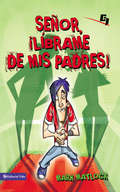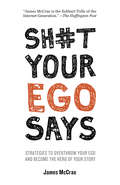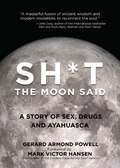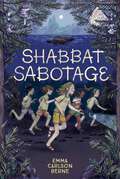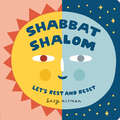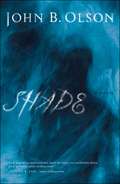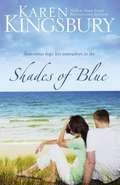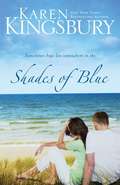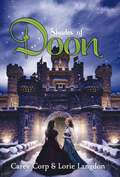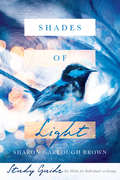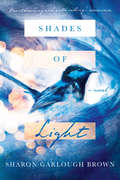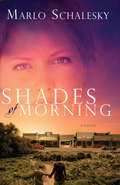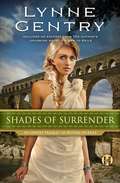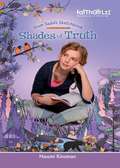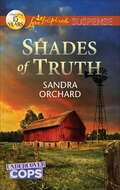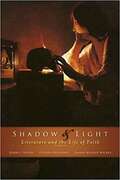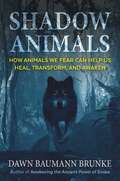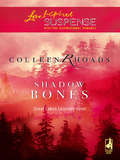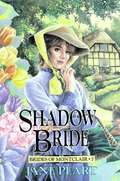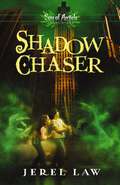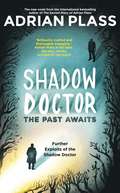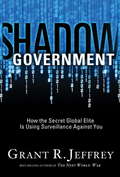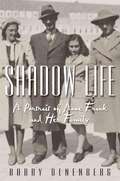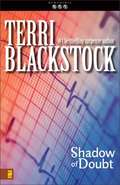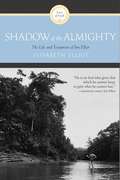- Table View
- List View
Señor, líbrame de mis padres
by Mark MatlockLo mismo para los adolescentes que para los padres, la idea de poder relacionarse correctamente unos con otros parece una utopía. Algunos piensan que es una misión imposible. Puede ser que se lleven bien la mayor parte del tiempo o que choquen los unos con los otros todo el tiempo. Señor, ¡líbrame de mis padres! te ayudará a entender ambas partes mucho mejor. Mark Matlock te dará una visión correcta y podrás comprender las dinámicas de las relaciones con tus padres. Obtendrás las herramientas idóneas para interactuar mejor con ellos. El resultado de leer este libro será una nueva perspectiva y una mejor y mucho más saludable relación con tus padres.
Sh#t Your Ego Says: Strategies To Overthrow Your Ego And Become The Hero Of Your Story
by James McCrae"Don’t read this book," your Ego says."Your life could change. And that scares me."Sometimes our worst failures lead to our greatest transformation.In 2012, James McCrae left behind a comfortable life in Minnesota and a successful career in advertising to move to New York City and pursue his dreams of being a writer. Soon after he arrived, Hurricane Sandy ripped through the eastern seaboard. New York City was underwater, and James —jobless and running out of money —was suddenly homeless. Fleeing to the island of Culebra for refuge, James sat alone on Flamenco Beach while his greatest doubts and insecurities rose to the surface. What he discovered was his Ego —and it had a lot of sh#t to say.This story of adventure, redemption, and transformation reminds us that we all have two voices inside us: the Ego and the Higher Self. The Ego is our reactive, attached mind that tells us we’re victims of circumstance. The Higher Self is our source of intuition and imagination that reminds us we’re the creators of our reality. Sh#t Your Ego Says exposes the battle between these voices.With arresting honesty and candid, compelling prose, James takes you through practical strategies for overthrowing your Ego and reclaiming a life of creativity and freedom. Whether you’re looking to achieve meaningful career success, improve your relationships, or unlock your imagination, this book provides a no-nonsense roadmap to living with purpose.
Sh*t the Moon Said: A Story of Sex, Drugs, and Ayahuasca
by Gerard Powell"It was during my eighth or ninth plant medicine journey that I was finally getting a real sense of freedom. I was feeling so elated that I told the moon I had a special request. I explained that this life had been so full of pain for me that I didn't think I could do it all again. So I asked her if in my next life she could make sure that I found the plant medicine as soon as possible. Her reply floored me. She typed, ‘Gerry, that's a request about next time, but it's the same one you used last time.'" Plant medicine? The moon typing? It probably seems incomprehensible. Gerard Armond Powell was a rags-to-riches success story—a member of the 1 percent—but also an extremely unhappy person with multiple addictions. On a fast track to destroying every relationship that ever mattered to him and considering suicide, he was looking for a miracle, a way out. He found it in the form of plant medicine and a shaman who introduced him to the truth of his life, and laid the groundwork for a psycho-spiritual journey that would lead him to reconnect with his soul, heal his addictions, and, finally, achieve a lasting sense of peace and happiness. This experience changed Powell, and convinced him to share the universal truths he learned with as many people as he could, which he does at the acclaimed Rythmia Life Advancement Center in Costa Rica, and now with readers in Sh*t the Moon Said. This mesmerizing story gives readers a blueprint to chart their own course to happiness. The first step is to learn who they really are and the possibilities of what they can still become. Second, they have to achieve a reconnection with their souls. And third, they must heal their hearts. Sh*t the Moon Said provides us with an irreverent way of highlighting our shared unconscious wisdom and its life-changing potential. Powell's candid tale and unlikely journey will help inspire readers to know themselves better, and to find the path to their own greatest redemption.
Shabbat Sabotage
by Emma Carlson BerneWelcome to Camp Shalom, a Jewish sleepaway camp that offers adventure and friendship! But when mysterious events start occurring, the campers will need to use their brains and work together-with some occasional sneaking around-to figure out what's really going on.Maya can't deny that she's nervous on the first day at Camp Shalom. She's never been to sleepaway camp before, she doesn't like insects and heat, and worst of all, she's afraid of swimming after an upsetting experience back at home. Maya feels a lot better about Camp Shalom after meeting friendly Dani, but she's not so sure about bossy Yael. When someone steals the special items their cabin needs to lead Shabbat, Maya and Dani do some sleuthing. They're no closer to catching the thief when Dani discovers that she is being accused. Now Maya really has to find out who sabotaged Shabbat-or her best friend will be sent home from camp. Meanwhile, she still has to pass the camp swimming test or she won't be able to go on the sleepover to Snake Island. Maya has a busy summer ahead, but with Dani's help-and maybe even Yael's-she will find out that honesty and the support of her friends can solve almost every problem.
Shabbat Shalom: Let's Rest and Reset
by Suzy UltmanThe second book in a stylish, current, and multi-faceted series of Jewish-themed casebound board books for curious young readers.This modern and whimsical Jewish-themed board book series is the first of its kind to incorporate both Jewish traditions and Jewish culture, offering a truly representative depiction of Judaism. Shabbat Shalom: Let's Rest and Reset introduces the Jewish day of rest, validating the varied experiences of Jewish readers, and informing and entertaining Jews and non-Jews alike! Author and artist Suzy Ultman melds her own Jewish upbringing with her current trendsetting aesthetic to create a much-needed series of gorgeous, appealing, and perfectly simple books that will stand out on any table or shelf amidst the sea of blue and gold painterly Jewish-themed books that precede these.
Shade
by John B. Olson"You will not fear the terror of the night." --Psalm 91. A monstrous waking nightmare is pursuing graduate student Hailey Maniates across San Francisco to Golden Gate Park where she is rescued by a towering homeless man. She seems able to read her rescuer's mind, but is it just a delusion? Doctors diagnose her as a paranoid schizophrenic and attempt to prescribe away her alleged hallucinations. But too many questions remain around Hailey and the man who saved her. He appears to suffer from her same mental condition and is convinced that some type of Gypsy vampire is trying to kill them both. Against reason, Hailey finds herself more and more attracted to this strange man. But what if he is a fantasy? What if he is the monster? Endorsements: "From its stunning first scene to its heartwarming last,Shade is a striking tale of mystery and danger that kept me hooked. This is Olson's finest work yet, and reading it, one gets the feeling he's just getting warmed up." Robin Parrish, author of Relentless and Merciless. "Unseen enemies. Questioned sanity. The weighing of reality. All the things I like in a book! The shadows are not silent. I lost sleep over this book. I got goose bumps from this book. The kind of scary that you crave and cringe at, Shade offers up a monster made more frightening by its originality. Thanks a lot, John Olson--because of you, I will not walk alone at night for a long time to come." Tosca Lee, author of Demon: A Memoir and Havah: The Story of Eve. "John B. Olson is a seasoned storyteller, and Shade is quite a story! As the heat turns up, and as menacing tones and brooding characters abound, the theme of God's grace boils to the surface. A few years back, Olson gave us a new twist on Jekyll & Hyde; now he puts his own fast-paced spin on the Dracula story. I can only hope there's a sequel in the works!" Eric Wilson, author of Field of Blood and A Shred of Truth. "Shade is a smart, gripping thriller. John B. Olson whips you along in a breakneck odyssey through a hellish paradise lost--and keeps you up all night doing it." Melanie Wells, author of My Soul to Keep and When the Day of Evil Comes. "Things that go bump in the night are not all figments of overwrought imaginations or evidence of mental illness. As our heroine discovers, evil personified preys on the ignorance of its victims. Lock your doors and windows, leave the lights on, and hunker down for a splendid, spine-chilling read." Donita K. Paul, author of the DragonKeeper Chronicles
Shades of Blue
by Karen KingsburyBrad Cutler is a rising star at his New York ad agency and about to marry the girl of his dreams. He seems to have it all, until memories of a high school girlfriend begin to torment him. Haunted by the past, he turns to God seeking forgiveness and redemption.
Shades of Blue
by Karen KingsburyBrad Cutler, twenty-eight, is a rising star at his New York ad agency, about to marry the girl of his dreams. Anyone would agree he has it all … a great career, a beautiful and loving fiancée, and a fairy tale life ahead of him—when memories of a high school girlfriend begin to torment him. Lost innocence and one very difficult choice flood his conscience, and he is no longer sure what the future will bring except for this: He must find his old love and make amends. Haunted by the past and confused about the future, he turns to God seeking forgiveness and redemption. Three people must work through the repercussions of a decision made long ago before any of them can look toward a new future.
Shades of Doon (A Doon Novel)
by Carey Corp Lorie LangdonAfter cheating death, Veronica Welling is determined to savor every moment in her idyllic kingdom with both her true love and best friend by her side at last. At the same time, Mackenna Reid is enthusiastically building her new life and a theater with her prince. But just as their dreams of happiness are within reach, the world Vee and Kenna have chosen is ripped away, leaving them to face their most horrific challenge yet—their old lives. Thrust out of Doon, the best friends are confronted with tormentors from their past and no way to return to their adopted land. When the MacCrae brothers rush to their rescue, the girls’ situation turns from nightmare to modern-day fairy tale. But their happiness could be short lived: unbeknownst to them, someone in their closest circle is aiding the witch of Doon in her bid to destroy the kingdom once and for all.
Shades of Light Study Guide
by Sharon Garlough BrownSharon Garlough Brown's novel Shades of Light is an exploration of depression, anxiety, caregiving, and the healing journey. In particular, it offers windows into the power of art as a spiritual practice. This six-week study guide is an opportunity for you to reflect on how the experiences of the characters in the novel resonate with your own experience. Daily Scripture readings and reflection questions are accompanied by an invitation to explore creativity through art and prayer collage. You'll also be introduced to the practice of visio divina (meditating on art) through a weekly link to a piece of art by Vincent van Gogh. With simple spiritual practices, this guide offers a healing balm for those in the midst of difficult seasons.
Shades of Light: A Novel
by Sharon Garlough Brown"I was desperate. . . . I couldn't turn off the dark thoughts, no matter how hard I tried or how much I prayed.
Shades of Morning: A Novel
by Marlo SchaleskyMarnie didn't know much about miracles. Mistakes maybe. Accidents. And monstrous mess-ups. She knew a lot about those. But miracles? Those were for other people. Marnie Wittier has life just where she wants it. Quiet. Peaceful. No drama. A long way away from her past. In the privacy of her home, she fills a box with slips of paper, scribbled with her regrets, sins, and sorrows. But that's nobody else's business. Her bookstore/coffee shop patrons, her employees, her friends from church-they all think she's the very model of compassion and kindness. Then Marnie's past creeps into her present when her estranged sister dies and makes Marnie guardian of her fifteen-year-old son-a boy Marnie never knew existed. And when Emmit arrives, she discovers he has Down syndrome-and that she's woefully unprepared to care for him. What's worse, she has to deal with Taylor Cole, her sister's attorney, a man Marnie once loved-and abandoned. As Emmit (and Taylor) work their way into her heart, Marnie begins to heal. But when pieces of her dismal past surface again, she must at last face the scripts of paper in her box, all the regrets and sorrows. Can she do it? Or will she run again?
Shades of Surrender: An eShort Prequel to Return to Exile (The Carthage Chronicles)
by Lynne GentryFrom Lynne Gentry comes this e-short prequel to The Carthage Chronicles and her upcoming novel, Return to Exile, shedding light on the love story of Ruth and Caecilianus and the beginnings of the church in Carthage and their relationship with the young Roman noble, Cyprian.Before Dr. Lisbeth Hastings took her unexpected tumble into third-century Carthage and found herself amidst the persecuted church, future bishop Caecilianus, then a famous dyer of imperial purple, was visiting the tapestry shop in the low-rent district every Tuesday. It may have been a part of his duties as the deacon tasked to check upon the widows and their families, but deep down, he knew it was because of Ruth, the widow's lovely daughter who was so very determined to get the family back on their feet of her own accord. Can Caecilianus break through Ruth's single-minded focus to show her the freedom of surrender? Or will Ruth's dogged self-sufficiency push away the man who loves her?
Shades of Truth
by Naomi KinsmanSadie is a strong, extroverted 12-year-old who sees the move from Menlo Park, CA to Eagle’s Nest, MI as a grand adventure. In this new place, she can be whoever she wants to be. She has a strong relationship with her fun-loving dad, and together they work hard to help her mom, who is emotionally fragile. They both hope that this new place will be a fresh start for Sadie’s mom. Quickly Sadie learns she is not welcome in Eagle’s Nest. Her father, a mediator called in by the DNR, is tasked with creating compromise between the hunters in the community who think the bears are a nuisance and should be shot, and the scientist who is studying the bears. Sadie has never been on the outside and isn’t sure what to do with the hostile treatment from many of the kids at school. She connects with one girl at school, which helps, and also starts to befriend the (good-looking) son of the scientist. Sadie also meets a local artist, who recognizes Sadie’s talent and offers her art lessons. As Sadie learns to draw, she starts to see her community in a new way. Her art teacher takes her to Compline (evening prayers) and Sadie is drawn in by the mystery of it all. She starts asking questions about what she believes, both in terms of faith, and in terms of the issues in her community. When her father doesn’t stand up to the hunters in the way she thinks he should, she questions his values. The focus of this first book is on Sadie stumbling into questions of faith, wrestling with them, and becoming more comfortable in the space of not knowing all the answers.
Shades of Truth (Undercover Cops #2)
by Sandra OrchardBig city detective Ethan Reed is working deep undercover at a Christian youth detention center. The kind of place he spent some harrowing time in as a kid. Ethan's mission: ferret out who's recruiting resident teens for a drug ring. He expects help from the lovely, devoted director of Hope Manor. But Kim Corbett won't tell Ethan anything-even when she's threatened and attacked. When Ethan discovers what Kim is protecting, his guarded heart opens just a bit wider. Enough to make this the most dangerous assignment of his career.
Shadow And Light: Literature And The Life Of Faith
by Jeanne Murray Walker Darryl Tippens Stephen WeathersThe third edition of this classic anthology features updated poetry and essays and drops the drama section making the new volume both more relevant and more affordable-and a perfect book for readers seeking spiritual enrichment Now in its third edition Shadow Light continues to stand apart because of what it offers readers rich inspiring and challenging excerpts from great literature spanning centuries and cultures all exploring the texture of faith and spirituality Unlike comparable titles that draw on explicitly Christian works this important anthology mines spiritual moments in so-called religious and secular texts alike introducing readers to a broader spectrum of literature and inviting them to expand the capacity of their souls A perennial favorite among professors students and general readers seeking wisdom and illumination this revised edition of Shadow Light features several key changes Most substantially the editors have deleted the full-length plays responding to reader comm
Shadow Animals: How Animals We Fear Can Help Us Heal, Transform, and Awaken
by Dawn Baumann Brunke• Explains how the animals we fear or dislike can help us recognize and investigate our shadow side: the hated, abandoned, judged, and denied aspects of ourselves• Explores the lessons of a wide variety of shadow animals, including snakes, rats, bats, and spiders, as well as those that only seem shadowy to some, such as dogs, cats, birds, and horses• Looks at the elements of the psyche each shadow animal represents and presents thirteen animal-inspired exercises designed to examine, embrace, and integrate our shadow selvesWe often project qualities onto animals that we don&’t wish to admit in ourselves. Thus, snakes are evil, spiders are creepy, rats are dirty, and so on. As Dawn Baumann Brunke explains, the animals we fear or dislike can help us to recognize our Shadow: the hated, abandoned, judged, and denied aspects of ourselves. As teachers and guides, shadow animals can help us to reclaim the inner strengths, abilities, and wisdom that we have forgotten or disowned. Brunke explores the lessons of numerous shadow animals, including those that many think of as shadowy, such as snakes and bats, as well as those that only seem shadowy to some, such as dogs, cats, birds, and horses. Though shadow animals may initially appear frightening, they offer profound healing and expert guidance in helping us identify, learn from, and embrace our shadow selves. Brunke explains how shadow animals represent unexamined elements of the psyche--from secret fears and suppressed emotions to unacknowledged prejudices and repressed trauma. She presents thirteen animalinspired exercises, each uniquely designed to help us find and better understand the lost, wounded pieces of our psyche. Presenting an animal-centered guide to shadow work, Brunke reveals how shadow animals protect and advise, challenge and encourage, inspire and offer support to the spiritual adventure of enlightenment as we awaken to who we really are.
Shadow Bones
by Colleen RhoadsThere were diamonds in that old family mine, Skye Blackbird was sure of it. She'd be able to prove it, too, and fulfill her Ojibwa chieftain father's dream, if it weren't for paleontologist Jake Baxter, who was searching for dinosaur bones in the very same spot. When sabotage occurred at the dig's site, Jake wasn't sure if it was angry locals or a rival paleontologist who had done it. But someone didn't want the earth disturbed, and as the body count mounted, it appeared that same someone might also want to add him and Skye to the tally. . . .
Shadow Bride
by Jane PeartFor Rod it was a moment out of a thousand dreams. Yet the reality was more than he could have imagined. "Blythe!" He said her name and in his voice was all the hope he'd thought was lost. The woman he saw was even lovelier than the girl he remembered. She was still as beautiful -- tall, slender, the glorious auburn hair, the soft, vulnerable mouth and peachbloom skin -- as when he had first met her at Montclair. At sixteen, Blythe had been shy, eager to be accepted and loved, now she was poised, fashionably dressed, self-confident. But in those same velvety brown eyes Rod saw what he was searching for -- that she still loved him. Would it be possible to bridge all the silent years that had separated them? Or had they changed too much? Had too much happened to make them different from the people they had been when they had fallen in love? Was it too late? Shadow Bride continues the story of the gallant bride of Malcolm Montrose, Blythe Dorman, who struggled so unselfishly to save a marriage that should never have been, that ended tragically before her son's birth. After heartbreak, despair, and sorrow, Blythe gathers up the fragments of her life and builds a new one for them both in England. Before she can find lasting happiness, Blythe must come to terms with her past, confront her heart's truth, and search for her own heritage. To find her real identity and true love, she has to meet these challenges and choices as the woman she has become, not as the girl she once was.
Shadow Chaser (Son of Angels, Jonah Stone)
by Jerel LawJoin part angel Jonah Stone as he faces his biggest challenge yet! Many months have passed since part angel siblings Jonah, Eliza, and Jeremiah Stone began their angelic training. As part angels, or quarterlings, the siblings joined other children of nephilim to begin honing their special powers. In this third installment in the Son of Angels series, Jonah’s story comes to resemble a modern-day Job as he’s faced with trials that affect his health, strength, relationships, and most-prized possessions. As he and the other quarterlings prepare for mid-term exams, their powers are tested once again in the most fierce battle against Abaddon’s forces yet. Will Jonah’s faith in Elohim continue to persevere as he fights Abaddon in his hardest battle yet? Parents today are looking for fiction that makes Christianity and the Bible exciting for their kids. This series is the first Christian answer to Percy Jackson and the Olympians, the Kane Chronicles, the Secret Series, and other middle-grade series packed with action, adventure, and supernatural fights. But the message is solidly based in Scripture, conveying God is always in control. Meets national education standards.
Shadow Doctor (Shadow Doctor Series): Further Exploits of the Shadow Doctor
by Adrian PlassMysteries are there to be solved. Aren't they?Jack has been working with the Shadow Doctor for a little while now. He thinks he might just be getting to grips with the Doc's unusual approach to helping with people's deep problems. Then, visiting the highly respected leader of a large Christian organisation, Jack sees his friend go on the attack. However, the encounter reveals secrets about the Doc's past that are beyond anything Jack could have imagined.Perturbed, he makes a list of all his unanswered questions. Where does the Shadow Doctor's unusual name come from? Why is he so stubbornly reluctant to speak about faith in terms that normal churchgoers would understand? Why is Jack not allowed to simply enjoy a moment when God really seems to have spoken through him? And will the Doc finally describe the life-changing experience mentioned by Jack's gran in the letter she wrote to him shortly before her death? Most all, Jack is desperate to pin down just what the Shadow Doctor actually thinks and feels about God.And there is one more issue that Jack feels particularly keenly. How will Doc respond to hearing that, having met a young lady named Aelwen, Jack is deeply in love for the very first time?
Shadow Government: How the Secret Global Elite Is Using Surveillance Against You
by Grant R. JeffreyIn an age of security cameras, spy chips hidden in consumer products, and an ultra-secret global elite, Jeffrey reveals the biblical description of Satan's global conquest and identifies the tools of technology that the Antichrist will use to rule the world.
Shadow Life: Portrait of Anne Frank and Her Family
by Barry DenenbergDenenberg presents the complete story of Anne Frank and her family's life, from Frankfurt, Germany, where Anne and Margot were born before the war, up through to their murders at the Bergen-Belsen concentration camp.
Shadow Of Doubt
by Terri BlackstockDetective Stan Shepherd lies comatose in the hospital, a victim of arsenic poisoning. The Newpointe police have a suspect. Celia Shepherd, Stan's wife. Celia is no stranger to such charges. When her first husband died of poisoning, a technicality scuttled the case against her, and Celia got off scot-free. Now it looks like the same old story--only this time, the motive appears plain. An old flame has moved into town under circumstances bound to raise suspicions. And that's just for starters. More evidence is gathering that could put Celia away for good. But attorney Jill Clark thinks the pieces of the puzzle fit together a bit too neatly. Either her client's Christian faith is a sham, or she is the victim of a deadly frame-up--and the real killer is still afoot... (Newpointe 911 book 2. Sequel to Private Justice.)
Shadow Of The Almighty: The Life & Testament Of Jim Elliot
by Elisabeth ElliotShadow of the Almighty is one of the great missionary stories of modern times. It is the life and testament of Jim Elliot, as told by Elliot’s widow, author and evangelist Elisabeth Elliot Gren. Shadow of the Almighty is the true account of Elliot's martyrdom, along with four fellow missionaries, at the hands of Ecuador’s Huaorani Indians. About this important and enlightening book, Eugenia Price writes, “It proves that Jesus Christ will bring bright creativity out of any shadow which might fall across any life and any love.” A story that has inspired Christian readers for more than half a century, it poignantly recounts a tragic event that was presented from Huaorani perspective in the 2006 feature motion picture, End of the Spear.
